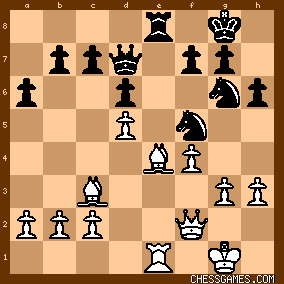| Aug-14-03 | | Helloween: 25.h4 could be good here. 26...Nf5 might be better than 26...f6. In this game, Lasker played a quite, positional Vienna Game with g3 and Bg2. He got a nice positional advantage after 8...Bxd5? and subsequently ended up with 2 Bishops vs. 2 Knights. His only positional weakness was the pawn on g3 after 17.f4, but it never came into play in the game. Black got greedy and grubbed the pawn on a2 with his Queen, which gave White time to attack the Kingside with mate threats. After winning a Knight, White was threatened with checkmate(34...Qh1#) and had to give back a piece, which enabled a Queen-trading pin. Black ended with an extra pawn in the endgame, but White's King is too actively placed, he has a Bishop against Knight and his pawns will easily reach promotion on the Kingside before Black's on the Queenside. 37.Bd2! is very correct, keeping the Bishop on the board and on the Queenside for defense. A nice win by Lasker. |
|
Mar-28-06
 | | keypusher: 
click for larger viewI just played over this game with the Lasker book. <Helloween> describes the overall course of the game quite well -- I just wanted to focus on the diagram above, which arises after 33...Kd7. White has been storming the kingside for some time, but his attack seems to have come to an end. Black is a piece down but threatens mate, and 34 Kh2 Qe2+ 35 Kg1 Qe3+ 36 Kf1 Qf3+ leads to perpetual check. If you play over the game to this point without knowing what's going to happen (as I did), a draw seems like the most legitimate outcome. Instead Lasker plays 34 Bxf5+! Qxf5+ 35 Qg4! Qxg4+ 36 Kxg4 Nxd5 37 Bd2!! 
click for larger view(The obvious 37 Bg7 is met by 37...Ne3+ 38 Kh5 Nf5.) Lasker has combined his way into an ending where he is a pawn down and seemingly has a bad bishop. But his further-advanced kingside pawns and king, mobile bishop and (as it turns out) his extremely well-placed b-pawn give him a very superior ending, which he wins. Two things strike me about the combination:
1. It takes real vision to see it -- not only are the tactics hard (for me) to work out, the idea of getting into an ending which looks so bad, and is at best incalculable, wouldn't even occur to me. For these reason this combination impresses me as much as any queen sacrifice. 2. Lasker really, really wanted to win! |
|
| Mar-29-06 | | Boomie: 37...Nf6 seemed to help white advance the pawns. 37...Ke7 is harder to crack. 37...Ke7 38. Kh5 Kf6 39. Kxh6 Kf5 40. h5
(40. Kg7 Nf6 41. g4+ Nxg4 42. h5 Nf6 43. h6 c5 44. Bc3 Nh5+ 45. Kf7 Nxf4 46. h7 Ng6 47. h8=Q Nxh8+ 48. Bxh8 d5 49. Ke7 Ke4 50. Kd6 d4 51. Kxc5 d3 52. Bc3 Ke3 53. Kb6 d2 54. Bxd2+ Kxd2 55. b4 Kc3=) 40...Kg4 41. Kg7! Kxh5 42. f5 Kg4 43. f6 Nxf6 44. Kxf6 Kxg3 45. Ke6 Kf3 46. Kd7 d5 47. Kxc7 b5
48. Kb6  |
|
Apr-02-06
 | | keypusher: <Boomie> In his book Soltis says only <Black's king can't stop the pawns by itself (37...Ke7 38 Kf5 Kf7 39 g4). His choice is between bringing the knight back or starting a pawn race with 37...c5.> He then concludes that White wins the race. In your last line I think 46...Ke2 (instead of 46...d5) might draw: 47 Bc3(?) Kd3 48 Kxc7 d5 49 Kxb7 d4 50 Ba5 (50 Bxd4 Kxd4 51 Kxa6 Kc4) Kc2 51 b4 d3. |
|
| Dec-11-08 | | Bycote: I think the position with white to move at move 34 would make a great Friday/Saturday puzzle. |
|
| Nov-08-09 | | Everett: 11.d4 is a nice change of pace. Flexible play. |
|
| Sep-19-11 | | Shams: <22. Be4!> (instead of the text, 22.Bf3) intending to push the g- and f- pawns is given by Soltis:
click for larger view "But you have to see that 22...h5 is met strongly by 23.Qf3 h4 24.Qg4!. White apparently didn't." |
|
| Oct-01-11 | | Cemoblanca: 16...a6
Lasker was more concerned with specific targets. He can see targets at g7 and h6 but he knows that he created a target for Black by leaving his a-pawn unprotected. To play 16.Rae1 he had to assure himself that 16...Qa4 would not be strong. Black apparently agreed, seeing Q-traps after 17.b3!, e.g. 17...Qxa2?? 18.Ra1 Qb2 19.Rfb1 Qc3 20.Nb5 Qb4 21.Ra4 or 17...Qb4? 18.c3 Qxc3 19.Nb5 Qb4? 20.Bd2. Better is 17...Qa5 18.Qb5 Qc3 or 18...Qxa2 but Black is still a bit south of equality. |
|
| Dec-22-14 | | TheFocus: Lasker's first triumph was winning the Hauptturnier A at the Breslau Congress. Lasker scored +7=2-0 in the Preliminaries and +4=0-2 in the Winners' group, but winning the play-off game with Feyerfeil. This is a round from the Winners' Group, July 24, 1889. |
|
| Dec-07-19 | | Everett: Lasker was such a beast |
|
| Oct-22-20 | | Helios727: In his Lasker book, Reinfeld goofed by giving: 26...Nf5 27.Qe4 Nge7 28.g4 Nh4+ 29.Kg3 Nxf3 30.Qxf3 Qxd5 31.Qe3 as winning for White when it is actually winning for Black. |
|
| Nov-06-23 | | Mathematicar: Beautiful, romantic and rustical opening. |
|





































